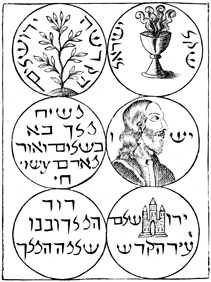Minted Hebrew Coins
Author: Leusden, Johannes, 1624-1699.
Image Title: Minted Hebrew Coins
Scripture Reference:
- Hebrews 9 (further images / scripture text)
Description: This image reproduces the front and back of three imitations of the Jewish shekels produced during the First War of the Jews against the Romans from 66-70 C.E. Because these coins were valuable historically and revered as biblical relics, Palestinian merchants fabricated and sold imitations of the coins to Europeans making pilgrimages to the Holy Land after the Crusades during the 14th century. These medals or tokens became extremely popular when marketed as examples of the “Thirty Pieces of Silver’ paid to Judas Iscariot for betraying Jesus. The smoking chalice on the top right coin face was a misinterpretation of two ancient Hebrew letters that represented the date of year two, Shin and Bet, located above the stemmed cup. Thus, some imitations were labeled “censer pieces” in reference to the misinterpretation of the authentic coin’s design as an incense burner. The branch on the reverse side confuses the authentic three budded pomegranate branch with Aaron’s miraculous budding staff (Hebrews 9:4), or as some authorities see it, the olive branch popular in early Christian art. The inscriptions which contain phrases such “Shekel of Israel,” “The Holy Jerusalem,” and “Yeshua,” are authentic in content, but inauthentic in paleography; they use the modern, square Hebrew (Aramaic) letter, while the genuine shekel was written in the ancient paleo-Hebrew alphabet. The illustrations on the front faces of the middle and bottom coins depict a profile of Jesus and a castle with three towers, an image commonly minted in the medieval period.
Click here for additional images available from this book.
Request a high-resolution file (fees apply)
Rights Statement: The online edition of this work in the public domain, i.e., not protected by copyright, has been produced by Pitts Theology Library, Emory University.
Rights Status: No Copyright - United States
Pitts Theology Library provides copyright information as a courtesy and makes no representation about copyright or other legal status of materials in the Digital Image Archive.

